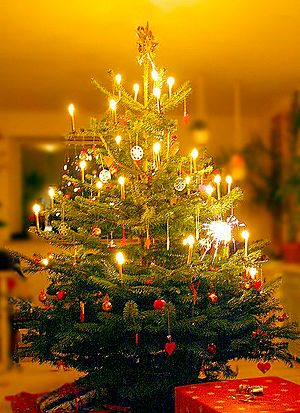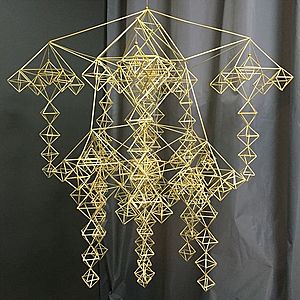Ziemassvētki facts for kids
Ziemassvētki, also called Ziemsvētki, is a special yearly celebration in Latvia. It marks the winter solstice, which is the shortest day of the year. It also celebrates the birth of Jesus Christ. People in Latvia and around the world celebrate Ziemassvētki from December 24 to 25. December 24 is called Ziemassvētku vakars, which means Christmas Evening. December 25 is Pirmie Ziemassvētki (First Christmas), and December 26 is Otrie Ziemassvētki (Second Christmas).
Most Christians celebrate Jesus' birthday on December 25. However, some Orthodox churches follow a different calendar. Because of this, many Orthodox churches celebrate Ziemassvētki on January 6, 7, and 8. Ziemassvētki is also celebrated by people who are not Christian. Today, common Ziemassvētki traditions include decorating a Ziemassvētku egle, visiting Ziemassvētku vecītis, baking piparkūkas (gingerbread cookies), and enjoying the smell of mandarins.
Contents
Decorating the Ziemassvētki Tree
Decorating fir trees for Ziemassvētki has been a custom in Livonia for a very long time. It was known even before the 1500s. The Blackheads Guild in Riga shared information about winter traditions in 1510. They mentioned similar events from as early as 1476. Because of this, some historians believe Riga was one of the first places to decorate a "Ziemassvētki tree" in 1476.
The Blackheads Guild said the early "tree" was more like a bouquet. In the Middle Ages, these bouquets were likely decorated with ribbons, dried flowers, straw dolls, and maybe fruits. Later, this "tree" might have been an "installation" made from wooden sticks. People would bring it outside with songs and dances. It stayed there for the whole Ziemassvētki period. Around January 6, it was burned in Town Hall Square. A similar tradition was seen in Tallinn (then called Revel) in 1514. It's possible this tradition then spread to other parts of the world.
Latvian Traditions
Old Latvian Traditions
Along with Ziemassvētki, an old Latvian tradition is called Yule Eve. This tradition involves pulling a log, which represents the sun's journey. In some places, Solstice Eve is also called Ķūķu Eve. This name points to an old holiday meal that was meant to bring good luck. This meal was made from crushed barley or wheat grains. These were boiled with half a pig's head. Peas and beans were often added too.
Another well-known Ziemassvētki tradition was ķekatas walking, or "gypsies walking." People dressed in different masks would go from village to village. They believed this would bring blessings and scare away bad spirits. So, these masked visitors were always welcomed and given treats. The leader of the budēļi (masked group) was called father budēļi or elder budēļi. He carried a special stick. He would gently tap everyone in the house with it. This was seen as a "ferrule of life." Latvians believed it had magical power for health and good crops. It was like a custom across Europe to use branches to bring life force to people and animals.
In different regions of Latvia, these masked groups had different names. In Courland and Semigallia, they were called budēļi (or bubuļi, buki). In Vidzeme, they were called vecīši or maskās. In Latgale, they were called kaļedās.
The idea of wearing masks came from old traditions about making things grow. People often tried to look like spirits. They wanted to either please these spirits or impress them. One popular mask was a bear. People believed a bear's growl could scare away all evil spirits. Buki masks were made by putting a flexible arch under a sheet. This was then covered with the sheet, and horns and a beard were added. For crane masks, people turned their fur coats inside out. They put an axe head in one sleeve and tied spoons to the sides to look like ears and a beak.
One custom was to dress up as death. A person would cover themselves with a white sheet. They would make fake teeth from turnips. One hand held a wooden dagger colored red. The other hand held a plate with something that could burn. This fire made the "death's" face look pale.
Modern Latvian Traditions
Today, Latvian Ziemassvētki decorations include spruce branches. People also make decorations from bird feathers, eggs, straw, and berries. Gifts are given, usually placed under the fir tree. To get a gift, children often have to say a poem or sing a song. A common tradition is that Ziemassvētku vecītis brings gifts. Sometimes, dwarfs or Snow White help him.
At children's Ziemassvētki parties, kids often dress up as wild animals and dwarfs. This comes from the old masking traditions. The old Father Budēļi or Elder character has also changed into Ziemassvētku vecītis because of new traditions.
See also
- Public holidays in Latvia
- Christmas tree



